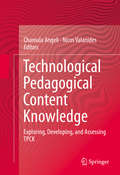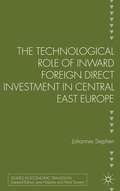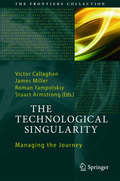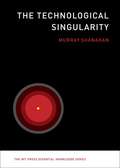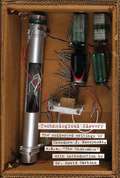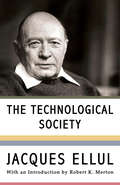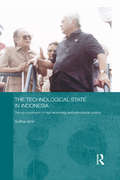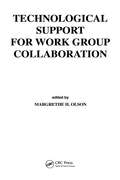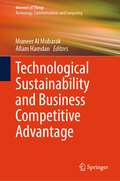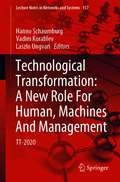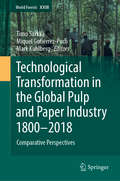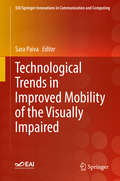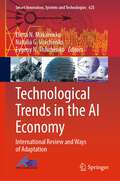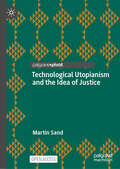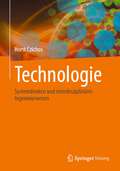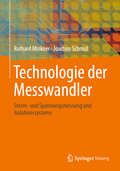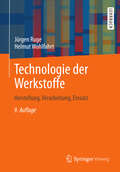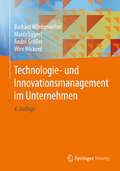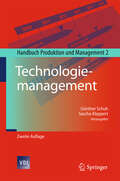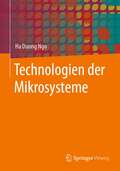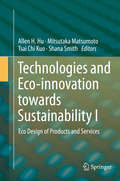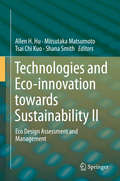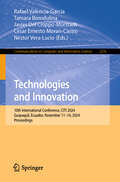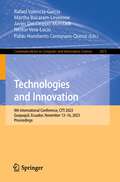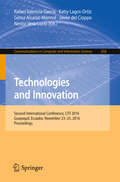- Table View
- List View
Technological Pedagogical Content Knowledge
by Charoula Angeli Nicos ValanidesTechnological pedagogical content knowledge (TPCK) reflects a new direction in understanding the complex interactions among content, pedagogy, learners and technology that can result in successful integration of multiple technologies in teaching and learning. The purpose of this edited volume is to introduce TPCK as a conceptual framework for grounding research in the area of teachers' cognitive understanding of the interactions of technology with content, pedagogy and learner conceptions. Accordingly, the contributions will constitute systematic research efforts that use TPCK to develop lines of educational technology research exemplifying current theoretical conceptions of TPCK and methodological and pedagogical approaches of how to develop and assess TPCK.
The Technological Role of Inward Foreign Direct Investment in Central East Europe
by Johannes StephanForeign direct investment (FDI) assumed a prominent role in Central East Europe (CEE) early on in the transition process. Foreign investors were assigned the task of restructuring markets, providing capital and knowledge for investment in technologically outdated and financially ailing firms.
The Technological Singularity
by Victor Callaghan James Miller Roman Yampolskiy Stuart ArmstrongThis volume contains a selection of authoritative essays exploring the central questions raised by the conjectured technological singularity. In informed yet jargon-free contributions written by active research scientists, philosophers and sociologists, it goes beyond philosophical discussion to provide a detailed account of the risks that the singularity poses to human society and, perhaps most usefully, the possible actions that society and technologists can take to manage the journey to any singularity in a way that ensures a positive rather than a negative impact on society. The discussions provide perspectives that cover technological, political and business issues. The aim is to bring clarity and rigor to the debate in a way that will inform and stimulate both experts and interested general readers.
The Technological Singularity
by Murray ShanahanThe idea that human history is approaching a "singularity" -- that ordinary humans will someday be overtaken by artificially intelligent machines or cognitively enhanced biological intelligence, or both -- has moved from the realm of science fiction to serious debate. Some singularity theorists predict that if the field of artificial intelligence (AI) continues to develop at its current dizzying rate, the singularity could come about in the middle of the present century. Murray Shanahan offers an introduction to the idea of the singularity and considers the ramifications of such a potentially seismic event. Shanahan's aim is not to make predictions but rather to investigate a range of scenarios. Whether we believe that singularity is near or far, likely or impossible, apocalypse or utopia, the very idea raises crucial philosophical and pragmatic questions, forcing us to think seriously about what we want as a species. Shanahan describes technological advances in AI, both biologically inspired and engineered from scratch. Once human-level AI -- theoretically possible, but difficult to accomplish -- has been achieved, he explains, the transition to superintelligent AI could be very rapid. Shanahan considers what the existence of superintelligent machines could mean for such matters as personhood, responsibility, rights, and identity. Some superhuman AI agents might be created to benefit humankind; some might go rogue. (Is Siri the template, or HAL?) The singularity presents both an existential threat to humanity and an existential opportunity for humanity to transcend its limitations. Shanahan makes it clear that we need to imagine both possibilities if we want to bring about the better outcome.
Technological Slavery
by Theodore J. Kaczynski David Skrbina"Like many of my colleagues, I felt that I could easily have been the Unabomber's next target. He is clearly a Luddite, but simply saying this does not dismiss his argument. . . . As difficult as it is for me to acknowledge, I saw some merit in the reasoning in [Kaczynski's writing]. I started showing friends the Kaczynski quote from Ray Kurzweil's The Age of Spiritual Machines; I would hand them Kurzweil's book, let them read the quote, and then watch their reaction as they discovered who had written it." -- Bill Joy, founder of Sun Microsystems, in "Why the Future Doesn't Need Us," Wired magazineTheodore J. Kaczynski has been convicted for illegally transporting, mailing, and using bombs, resulting in the deaths of three people. He is now serving a life sentence in the supermax prison in Florence, Colorado.The ideas and views expressed by Kaczynski before and after his capture raise crucial issues concerning the evolution and future of our society. For the first time, the reader will have access to an uncensored personal account of his anti-technology philosophy, which goes far beyond Unabomber pop culture mythology.Feral House does not support or justify Kaczynski's crimes, nor does the author receive royalties or compensation for this book. It is this publisher's mission, as well as a foundation of the First Amendment, to allow the reader the ability to discern the value of any document.David Skrbina, who wrote the introduction, teaches philosophy at the University of Michigan, Dearborn.
The Technological Society
by Jacques EllulAs insightful and wise today as it was when originally published in 1954, Jacques Ellul's The Technological Society has become a classic in its field, laying the groundwork for all other studies of technology and society that have followed. Ellul offers a penetrating analysis of our technological civilization, showing how technology—which began innocuously enough as a servant of humankind—threatens to overthrow humanity itself in its ongoing creation of an environment that meets its own ends. No conversation about the dangers of technology and its unavoidable effects on society can begin without a careful reading of this book. "A magnificent book . . . He goes through one human activity after another and shows how it has been technicized, rendered efficient, and diminished in the process.&”—Harper's &“One of the most important books of the second half of the twentieth-century. In it, Jacques Ellul convincingly demonstrates that technology, which we continue to conceptualize as the servant of man, will overthrow everything that prevents the internal logic of its development, including humanity itself—unless we take necessary steps to move human society out of the environment that 'technique' is creating to meet its own needs.&”—The Nation &“A description of the way in which technology has become completely autonomous and is in the process of taking over the traditional values of every society without exception, subverting and suppressing these values to produce at last a monolithic world culture in which all non-technological difference and variety are mere appearance.&”—Los Angeles Free Press
The Technological State in Indonesia: The Co-constitution of High Technology and Authoritarian Politics (Routledge Contemporary Southeast Asia Series)
by Sulfikar AmirUsing a historical sociology approach, this book illustrates the formation of the technological state in Indonesia during the New Order period (1966-1998). It explores the nexus between power, high technology, development, and authoritarianism situated in the Southeast Asian context. The book discusses how the New Order regime shifted from the developmental state to the technological state, which was characterized by desire for technological supremacy. The process resulted in the establishment of a host of technological institutions and the undertaking of large-scale high-tech programs. Shedding light on the political dimension of socio-technological transformation, this book looks at the relationship between authoritarian politics and high technology development, and examines how effectively technology serves to sustain legitimacy of an authoritarian power. It explores into multiple features of the Indonesian technological state, covering the ideology of development, the politics of technocracy, the institutional structure, and the material and symbolic embodiments of high technology, and goes on to discuss the impact of globalization on the technological state. The book is an important contribution to studies on Southeast Asian Politics, Development, and Science, Technology, and Society (STS).
Technological Support for Work Group Collaboration
by Margrethe H. OlsonThis text discusses the emerging trend in product development and research that focuses on the increasingly important relationship between computer systems and social systems. The text emphasizes the significance of building tools to help people work together and the need for the identification of key factors within an organization to create systems more beneficial to users. Also contained are reviews of current research and discussions of both established tools, such as electronic mail and computer conferencing, and those newly developed programs that emphasize "work group" productivity over individual productivity.
Technological Sustainability and Business Competitive Advantage (Internet of Things)
by Muneer Al Mubarak Allam HamdanThis book discusses advanced technological solutions in Industry 5.0 that can be used for business competitive advantage and sustainability. The book presents tools that can help reduce time and make use of data in an efficient way while using resources efficiently and sustainably. The book aims to highlight technological sustainability through promoting innovations, improving social development, and providing green products that benefit the society. The authors discuss the recent technological advancements such as Artificial Intelligence (AI), Internet of Things (IoT), Financial Technology (FinTech), Big Data, and Blockchain. They also discuss the benefits of incorporating such technologies in areas such as green supply chain, storage technology, Internet banking, and nanotechnology. The target audience of this book includes all interested individuals and institutions in the fields of engineering, business, technology, and public services. The book provides insights and solutions to many issues and creates opportunities for further sustainability.
Technological Transformation: TT-2020 (Lecture Notes in Networks and Systems #157)
by Hanno Schaumburg Vadim Korablev Ungvari LaszloThis proceedings book contains 21 articles that arouse the greatest interest among experts from academia, industry and scientific experts in the area of the structural transformation of industrial and economic systems on a new technological base. V Scientific International Conference «Technological Transformation: A New Role for Human, Machines and Management (TT-2020)» was held on 16–18 September 2020 in St. Petersburg at the Peter the Great St. Petersburg Polytechnic University. The conference aimed to discuss the results of system studies on the key drivers and consequences of wide digitalization in various sectors of the economy and industry, as well as in the service sector. Topics were presented: New industrial base, Virtual engineering, Diffusion of technology, Digital infrastructure, Supercomputers, Cyberphysical interface and Informatics of cognitive processes, Convergence, harmonization and integration of artificial and natural intelligence, Changing social and economic landscape and new management systems, Digital technologies in logistics, Cyberphysical systems and artificial intelligence.
Technological Transformation in the Global Pulp and Paper Industry 1800–2018: Comparative Perspectives (World Forests #23)
by Timo Särkkä Miquel Gutiérrez-Poch Mark KuhlbergThis contributed volume provides 11 illustrative case studies of technological transformation in the global pulp and paper industry from the inception of mechanical papermaking in early nineteenth century Europe until its recent developments in today’s business environment with rapidly changing market dynamics and consumer behaviour. It deals with the relationships between technology transfer, technology leadership, raw material dependence, and product variety on a global scale. The study itemises the main drivers in technology transfer that affected this process, including the availability of technology, knowledge, investments and raw materials on the one hand, and demand characteristics on the other hand, within regional, national and transnational organisational frameworks.The volume is intended as a basic introduction to the history of papermaking technology, and it is aimed at students and teachers as course material and as a handbook for professionals working in either industry, research centres or universities. It caters to graduate audiences in forestry, business, technical sciences, and history.
Technological Trends in Improved Mobility of the Visually Impaired (EAI/Springer Innovations in Communication and Computing)
by Sara PaivaThis book provides an insight into recent technological trends and innovations in mobility solutions and platforms to improve mobility of visually impaired people. The authors' goal is to help to contribute to the social and societal inclusion of the visually impaired. The book’s topics include, but are not limited to, obstacle detection systems, indoor and outdoor navigation, transportation sustainability systems, and hardware/devices to aid visually impaired people. The book has a strong focus on practical applications, tested in a real environment. Applications include city halls, municipalities, and companies that can keep up to date with recent trends in platforms, methodologies and technologies to promote urban mobility. Also discussed are broader realms including education, health, electronics, tourism, and transportation. Contributors include a variety of researchers and practitioners around the world.Features practical, tested applications of technological mobility solutions for visual impaired people;Presents topics such as obstacle detection systems, urban mobility, smart home services, and ambient assisted living;Includes a number of application examples in education, health, electronics, tourism, and transportation.
Technological Trends in the AI Economy: International Review and Ways of Adaptation (Smart Innovation, Systems and Technologies #625)
by Elena N. Makarenko Natalia G. Vovchenko Evgeny N. TishchenkoThis book is devoted to the study of artificial intelligence from a new perspective – not just a technology but a social institution with complex social connections and relationships. The book systematically highlights technological trends of the artificial intelligence economy and considers all the components of its cascade effect with an overview of international experience and substantiation of promising ways of adapting to the modern stage of technological transit of economic systems. The cascade effect is understood as a chain of interdependent events that are triggered as artificial intelligence takes root in society and the economy. Among the technological trends (current areas of the practical application of artificial intelligence), highlighted in the book, are “smart” homes, digital regions, the use of artificial intelligence to ensure cybersecurity, as well as the optimization of business processes based on artificial intelligence.The book interprets the economics of artificial intelligence as a result of the transition to a digital technological order. A review of modern experience and regulatory perspectives of the institutionalization of the artificial intelligence economy is carried out. The legal framework for combating cyber threats in the artificial intelligence economy has been determined. The promising frameworks for using artificial intelligence in various branches of industry are presented. The book provides practical examples, case studies and proposed frameworks for using AI in various sectors of the economy, which allows using the book as a practical guide to managing the artificial intelligence economy.
Technological Utopianism and the Idea of Justice
by Martin SandThis open access book advances a modest defence of technological utopias. While technological utopianism is not devoid of risks and elitism, their benefits should not be discounted in an overall assessment. Rather than rejecting them based on a too narrow definition of utopianism, we must acknowledge their potential to exceed the individualist vs. collectivist dichotomy ascribed to traditional utopias. The author argues, with reference to Rawls’ idea of the basic structure that technological utopias challenge our understanding of the scope and location of justice and, thereby, advance the idea of justice. The book critically reviews the most recent literature in political philosophy, where utopias are understood as ideal theories of justice and sides with recent contributions to Utopian Studies, where utopias’ potential to estrange from the present and galvanize action are underscored.
Technologie: Systemdenken und interdisziplinäres Ingenieurwesen
by Horst CzichosDieses prägnante Lehrbuch führt einen Systemansatz in die Technik ein und beschreibt tribologische, mechatronische und cyber-physikalische Systeme sowie das technologische Konzept der Industrie 4.0 für Studierende verschiedener technischer Fachrichtungen. "Technologie" bezieht sich in diesem Buch auf die Gesamtheit der vom Menschen geschaffenen, nutzenorientierten Produkte, die auf technischen Kombinationen von Material, Energie und Information basieren. Dr. Czichos untersucht Technologie in diesem Band im Kontext des Systemdenkens im Hinblick auf die folgenden Haupttechnologiebereiche:Technische Systeme mit "interagierenden Oberflächen in Relativbewegung", insbesondere im Maschinenbau, in der Produktion und im Transportwesen; einschließlich der Analyse von reibungsbedingten Energieverlusten und verschleißbedingter Materialdissipation. Technische Systeme, die eine Kombination aus Mechanik, Elektronik, Steuerung und Computertechnik für die Bedürfnisse von Industrie und Gesellschaft erfordern. Technische Systeme mit einer Kombination aus Mechatronik und Internetkommunikation. Cyber-physikalische Systeme für die Digitalisierung der Industrie im Entwicklungsprojekt Industrie 4.0.Betrachtet Technik als Kombination aus der physischen Welt und der digitalen virtuellen Welt der Information und Kommunikation.Beschreibt den Produktzyklus von technischen Systemen und die Eckpfeiler der Technik: Material, Energie und Information.Stellt eine ganzheitliche Betrachtung von Technik und Engineering dar.
Technologie der Messwandler: Strom- und Spannungsmessung und Isolationssysteme
by Ruthard Minkner Joachim SchmidIn diesem Buch werden die bestehenden Wandlertechnologien, sowie neue Messprinzipien für die Messung von Strom und Spannung in Energieübertagungs- und Energieverteilsystemen beschrieben. Die Eigenschaften der konventionellen Stromwandler und Spannungswandler sowie deren Dimensionierung werden aus der Sicht der langjährigen Erfahrung der Autoren detailliert besprochen. Dabei wird vor allem auch auf die dielektrische Auslegung und die eingesetzten Materialien eingegangen. Daneben wird ein Überblick moderner neuer Messprinzipien gegeben und die Technologie der Kleinsignalstromwandler und RC-Teiler detailliert dargestellt.
Technologie der Werkstoffe: Herstellung, Verarbeitung, Einsatz
by Helmut Wohlfahrt Jürgen RugeIn diesem Fachbuch werden Grundkenntnisse zur Werkstofftechnologie praxisbezogen, verständlich und anschaulich vermittelt. Auf dieser Basis wird das Verständnis für spezielle Bedingungen und Abläufe wichtiger technologischer Prozesse gefördert. Die Auswirkungen der jeweiligen Herstellungsverfahren auf die Eigenschaften der Werkstoffe und Halbzeuge werden ausführlich behandelt. In der vollständig normenaktualisierten Auflage wurden nicht mehr relevante Themen gestrafft sowie das Sachwortverzeichnis vollständig überarbeitet und verbessert. Jedes Kapitel erhielt eine Kurzzusammenfassung.
Technologie- und Innovationsmanagement im Unternehmen: Lean Innovation (Vdi-buch Ser.)
by Burkard Wördenweber Marco Eggert André GrößerDer globale Wettbewerb verändert das Umfeld, in dem Firmen agieren. Um nicht an den Rand gedrängt zu werden, sind Unternehmen gezwungen, sich selbst zu erneuern, indem sie kontinuierlich Prozesse verbessern, Produkte mit Mehrwert entwickeln und Kundenwünsche aufspüren. Die Autoren beschreiben in der 3. Auflage anhand sechs neuer Themen weitere Methoden zur Gestaltung dieses Erneuerungsprozesses. Der Praxisleitfaden enthält schnell umsetzbare Praxistipps und nützliche Software-Tools für ein erfolgreiches Innovations- und Technologiemanagement.
Technologiemanagement
by Günther Schuh Sascha KlappertDer 2. Band der Buchreihe "Produktion und Management" konzentriert sich auf den Umgang mit Technologien. Die Autoren nehmen Technologiestrategien zum Ausgangspunkt und führen in die grundlegenden Zusammenhänge, Vorgehensweisen und Methoden des Technologiemanagements ein: von der Technologiefrüherkennung über die Technologieplanung, Technologieentwicklung und Technologieverwertung bis zur Technologiebewertung. Leser können sich einen Überblick zum Thema Technologiemanagement verschaffen und den Stoff anhand realer Fallbeispiele nachvollziehen.
Technologien der Mikrosysteme
by Ha Duong NgoDas Buch vermittelt die Grundlagen zur Herstellung und dem Aufbau von Mikrosystemen. Es kann in zwei Teile aufgeteilt werden. Der Schwerpunkt von Teil I liegt hierbei auf den Mikrofertigungsprozessen und behandelt die Siliziumtechnologie, mikromechanische Strukturierungs- (anisotropes Ätzen, DRIE) und Bondprozesse (Eutectic Bonding, Fusion Bonding). Teil II behandelt die Aufbau- und Verbindungstechnik für Mikrosysteme und vermittelt Kenntnisse zu den Prinzipien der Chipmontage. Dabei stehen u.a. die Beschichtungstechnologien (Metallisierungssysteme) und Kontaktiertechnologien (Löten, Kleben, Bonden) im Vordergrund.
Technologies and Eco-innovation towards Sustainability I: Eco Design of Products and Services
by Mitsutaka Matsumoto Allen H. Hu Tsai Chi Kuo Shana SmithThis 2-volume book covers the state-of-the-art of the research and practices on eco-design. It covers the latest topics in the field: e.g. global eco-design management, big data in eco-design, social perspectives in eco-design; as well as emphasizing the developments in emerging economies such as Asian countries. Eco-design of products and product-related services are indispensable to realize the circular economy and to increase resource efficiencies of our society. Eco-design practices are necessary both in developed countries and developing countries. The book chapters are contributed by the worldwide authors, especially authors from East Asian countries, European countries, and Southeast Asian countries, and contains selected presentations at the EcoDesign2017 symposium (10th International Symposium on Environmentally Conscious Design and Inverse Manufacturing). The first volume highlights products and services, the chapters include the product life cycle design and business strategy, technologies for the future and sustainability, as well as social perspectives in eco-design.
Technologies and Eco-innovation towards Sustainability II: Eco Design Assessment and Management
by Allen H. Hu Mitsutaka Matsumoto Tsai Chi Kuo Shana SmithThis 2-volume book covers the state-of-the-art of the research and practices on eco-design. It covers the latest topics in the field: e.g. global eco-design management, big data in eco-design, social perspectives in eco-design; as well as emphasizing the developments in emerging economies such as Asian countries. Eco-design of products and product-related services are indispensable to realize the circular economy and to increase resource efficiencies of our society. Eco-design practices are necessary both in developed countries and developing countries. The book chapters are contributed by the worldwide authors, especially authors from East Asian countries, European countries, and Southeast Asian countries, and contains selected presentations at the EcoDesign2017 symposium (10th International Symposium on Environmentally Conscious Design and Inverse Manufacturing).The second volume focus on assessment and management, including topics such as sustainable manufacturing and End of Life (EOL) management, sustainability assessment, policy and regulations and Incentives for eco-design.
Technologies and Innovation: 10th International Conference, CITI 2024, Guayaquil, Ecuador, November 11–14, 2024, Proceedings (Communications in Computer and Information Science #2276)
by Rafael Valencia-García Tamara Borodulina Javier Del Cioppo-Morstadt Cesar Ernesto Moran-Castro Néstor Vera-LucioThis book constitutes the refereed proceedings of the 10th International Conference on Technologies and Innovation, CITI 2024, held in Guayaquil, Ecuador, during November 2024. The 15 full papers presented in this volume were carefully reviewed and selected from 38 submissions. These papers have been organized under the following topical sections: Artificial intelligence in Agriculture; Natural language processing and semantic web; Machine learning; Software tools.
Technologies and Innovation: 9th International Conference, CITI 2023, Guayaquil, Ecuador, November 13–16, 2023, Proceedings (Communications in Computer and Information Science #1873)
by Rafael Valencia-García Martha Bucaram-Leverone Javier Del Cioppo-Morstadt Néstor Vera-Lucio Pablo Humberto Centanaro-QuirozThis book constitutes the refereed proceedings of the 9th International Conference on Technologies and Innovation, CITI 2023, held in Guayaquil, Ecuador, during November 13–16, 2023. The 20 full papers included in this book were carefully reviewed and selected from 51 submissions. They were organized in topical sections as follows: Machine Learning; Natural Language Processing and Semantic Web; Computer vision; and Knowledge-based systems.
Technologies and Innovation
by Rafael Valencia-García Katty Lagos-Ortiz Gema Alcaraz-Mármol Javier Del Cioppo Nestor Vera-LucioThis book constitutes the refereed proceedings of the Second International Conference on Technologies and Innovation, CITI 2016, held in Guayaquil, Ecuador, in November 2016. The 21 revised full papers presented were carefully reviewed and selected from 65 submissions. The papers are organized in topical sections on knowledge representation and natural language processing; Cloud and mobile computing; software engineering; expert systems and soft computing.
